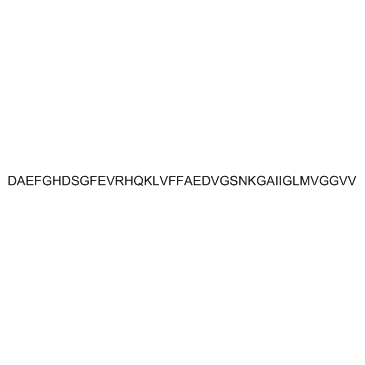Amyloid β-Protein (1-40) (mouse, rat)

Amyloid β-Protein (1-40) (mouse, rat) structure
|
Common Name | Amyloid β-Protein (1-40) (mouse, rat) | ||
|---|---|---|---|---|
| CAS Number | 144409-98-3 | Molecular Weight | 4233.778 | |
| Density | N/A | Boiling Point | N/A | |
| Molecular Formula | C190H291N51O57S | Melting Point | N/A | |
| MSDS | N/A | Flash Point | N/A | |
Use of Amyloid β-Protein (1-40) (mouse, rat)Amyloid β-peptide (1-40) (rat) is the prone-to-aggregation product of amyloid precursor protein proteolytic cleavage, and is the major constituent of senile plaques observed in the brain of Alzheimer’s disease. |
| Name | amyloid beta-protein (1-40) (mouse, rat) |
|---|---|
| Synonym | More Synonyms |
| Description | Amyloid β-peptide (1-40) (rat) is the prone-to-aggregation product of amyloid precursor protein proteolytic cleavage, and is the major constituent of senile plaques observed in the brain of Alzheimer’s disease. |
|---|---|
| Related Catalog | |
| Target |
The Amyloid β-peptide (1-40) (rat)-treated rats require longer to find the platform hidden under the water. In the visible platform test, the latency for each group is similar (20.56±11.31 s in control and 14.68±9.97 s in Amyloid β-peptide (1-40) (rat) group, p=0.304). Among these tested proteins, 6 ones are significantly up-regulated and 7 ones significantly down-regulated in Amyloid β-peptide (1-40) (rat) group comparing with the control. Tubulin β chain is significantly down-regulated in Amyloid β-peptide (1-40) (rat) group (p=0.014) when compare with control. Similar changes are also observed for ATP synthase β subunit (p=0.010) and synapsin Ib between Amyloid β-peptide (1-40) (rat) and control groups, but not significantly for synapsin Ib (p=0.295)[1]. |
| Animal Admin | Eight-week-old male Sprague-Dawley rats (n=14) weighing 200 to 220 g are used in this study. The rats are housed in plastic cages with food and water supplied ad libitum, and are maintained on a 12-h light/dark cycle at room temperature (21 to 23°C). 14 rats are randomly divided into two groups: (1) Milli-Q water-injected rats serve as the control group and (2) fibrillar neurotoxic Amyloid β-peptide (1-40) (rat) injected rats serve as the Amyloid β-peptide (1-40) (rat) group. Fibrillar Amyloid β-peptide (1-40) (rat) or Milli-Q water (2 μL) is injected at a flow rate of 0.5 μL/min. Following injection, the needle is maintained in place for 5 min prior to its slow extraction. A second injection is also administered at the same coordinate in the opposite hemisphere. The behavioral performances of animals are assessed by the step-down passive avoidance test and Morris water maze test[1]. |
| References |
| Molecular Formula | C190H291N51O57S |
|---|---|
| Molecular Weight | 4233.778 |
| Exact Mass | 4233.123 |
| AMyloid b-Protein (1-40) (Mouse, rat) |
| Rat aMyloid-β peptide 1-40 |
| Amyloid beta-peptide (1-40) (rat) |
| Amyloid β-peptide (1-40) (rat) |
| Rat aMyloid-beta peptide 1-40 |
| H-Asp-Ala-Glu-Phe-Gly-His-Asp-Ser-Gly-Phe-Glu-Val-Arg-His-Gln-Lys-Leu-Val-Phe-Phe-Ala-Glu-Asp-Val-Gly-Ser-Asn-Lys-Gly-Ala-Ile-Ile-Gly-Leu-Met-Val-Gly-Gly-Val-Val-OH |